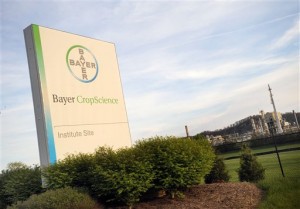Bayer Corporation wants to have a convenient supply of product for its New Martinsville,WV and Institute, WV manufacturing plants and Acting Governor Earl Ray Tomblin has created a Marcellus to Manufacturing Task Force charged with the mission of making that happen for Bayer and potentially other chemical corporations. The Governor has ordered the executives of several gas production companies, as well as other helpful principles such as reps from economic development agencies, labor, and state government to come to the table with Bayer Corporation and the Chemical Alliance Zone primarily for the purpose of expediting the development of an ethane cracker plant. An ethane cracker plant is the missing link between the natural gas industry and the chemical industry. It converts ethane, another constituent of natural gas, to ethylene. Bayer currently purchases an estimated 200 million pounds of ethylene oxide which is shipped from the Gulf region for use as feedstock in manufacturing other chemical compounds.
Before mid-January, when Dominion Resources announced that it has reached an agreement with PPG Industries on an option for Dominion to purchase land at PPG’s Natrium, WV, site, it seemed unlikely that a ethane cracker plant, estimated cost $1 billion, would materialize in West Virginia. The land is being purchased by Dominion as a site for a fractionation plant to separate non-methane components, including ethane, butane and propane, from natural gas. The Natrium site is only about 9 miles north of Bayer’s New Martinsville, W.Va. facility and is close to Dominion’s TL-404 pipeline which that firm plans to convert into a wet gas service line. Natural gas is referred to as wet gas before the heavier hydrocarbons such as ethane are removed. The Natrium site also is close to railroad, pipeline and barging services for transport of natural gas liquids.
As independent efforts by Bayer to entice a cracker plant to move in next door appear to have been nonproductive, it would greatly behoove Bayer to negotiate a deal to build a stakeholder partnership between the gas producers, the fractionator (Dominion), and an ethane producer/cracker plant operator. In addition to the cost savings of cheaper feedstock (transport costs nearly eliminated) as a motivator, the company has recently had to adapt to the loss of production. In August, 2010, Bayer was forced to agree to phase out production of aldicarb (trade name Temik) after this EPA finding: A new risk assessment conducted by EPA based on recently submitted toxicity data indicates that aldicarb no longer meets our rigorous food safety standards and may pose unacceptable dietary risks, especially to infants and young children. A closely related issue is the storage of methyl isocyanate gas (MIC), an ingredient of aldicarb, at the Institute plant. Twice as much of the highly toxic compound was stored there as was involved in the grueseome catastrophe in Bhopal, India in 1984. Half a million people were injured or killed after an explosion released the deadly MIC gas at a Union Carbide plant – the worlds’s worst industrial disaster. There had been public pressure to eliminate the storage of MIC at Institute prior to an August 2008 explosion at the Institute plant which killed 2 workers and led a congressional investigation to conclude that “it could have been worse than Bhopal.” This issue has been in recent news and a hearing is scheduled for Feb. 25th. The point is that Bayer has idle capacity at both of its WV plants; in January it was announced that 220 workers would be laid off at Institute, 44% of their workforce there. Bayer has motivation to be flexible in negotiations for a cracker plant deal as it seeks ways to return the plant to capacity. Incidentally, Bayer’s new CEO, Greg Babe, has a personal connection with New Martinsville; it’s his hometown.
A cracker in West Virginia would benefit the gas production companies because then the ethane would not have to be piped elsewhere. Historically, natural gas production has been the magnet for ethane crackers. Currently pipeline projects are being planned to move Marcellus ethane to the crackers in the Gulf region.
Among the likely candidates which may be courted for cracker plant development are Chevron, Shell, Exxon and Reliance, each of which have a more than $1 billion stake in the Marcellus Shale. Others are BP, Dow Chemical, Formosa Plastics, LyondellBasell, Koch Industries, and Westlake Chemical.
Will the public be expected to be a partner in this venture? Will TIF funds be awarded a project that emerges from the Task Force efforts? Why is there public representation in a corporate businessroom? Will, in fact, we, the citizens of West Virginia, be expected to participate in a public plan to subsidize private industry in a recovery which would lead to job creation or restoration? Of course, Bayer may not be the only chemical corporation to benefit. But it is certainly poised to be the immediate beneficiary of any successful effort to bring an ethane cracker plant to the Kanawha Valley area.


{ 1 comment… read it below or add one }
Help the MIC Legal fund! Share this link!